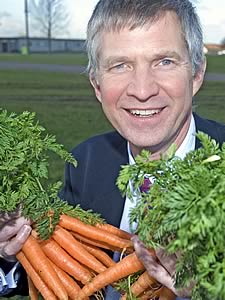 |
|||||||||
|
|||||||||||||||||||
|
|
Carrot Clip Cuts Sclerotinia Risk A novel technique to clip carrot foliage along the edges of rows could provide an additional route to reducing damaging Sclerotinia infection, according to independent crop consultant, Howard Hinds.
Speaking at a Syngenta Agronomy Update meeting for carrot growers in Nottinghamshire last week (16 March), Mr Hinds reported that Sclerotinia infection typically starts on the bed edges, where weakened foliage falls into the rows and is more susceptible to disease pathogen infection. The dense foliage of Nairobi is especially vulnerable to collapse soon after full cover, he warns. A new option currently under evaluation is to mechanically trim off the outside leaves, maintaining healthy upright foliage and reducing risk of initial infection. “Field-scale trials in 2009 and 2010 have shown some very useful reductions in Sclerotinia infection – typically up to 60%,” he reported. Results can be improved further with carrots grown on a ridge system, with a clip at row closure stage showing the greatest benefit. “Clipping opens up air flow through the foliage to reduce disease pressure, as well as allowing more effective application of fungicides,” he advised. Mr Hinds believes the clipping technique could prove a valuable additional ICM approach that will work alongside a full fungicide programme to help growers manage Sclerotinia more effectively.
Fungicide strategy With Sclerotinia control the greatest foliar disease challenge facing growers, Syngenta Technical Manager, Jon Ogborn, stressed the need for a season-long programme and the importance of alternating fungicides to maintain protection. The new introduction of Switch has given a crucially important effective alternative to strobilurin and triazole chemistry, he advised. The combination of two actives provides a high level of protection of the leaf and root crown surface with fludioxonil, whilst the cyprodinil element can also enter into the leaf and move within the plant. “Switch is complementary to the strobilurin fungicides that have made such an impact in managing Sclerotinia in carrots. ADAS trials in Nottinghamshire have shown that it can achieve very high levels of control – reducing infection to less than 5%, compared to over 35% in untreated plots.” The experience of growers and agronomists suggests the best option to counter both Sclerotinia and Alternaria would be to start the programme with Switch at 60% canopy closure, and then alternate with Amistar Top at two to three week intervals according to disease pressure.
Application technique Carrot leaves attract spray droplets, which makes penetration of Sclerotinia fungicide sprays through the dense crop canopy to target lower stems and root crowns a difficult challenge for sprayer operators. Ian Holmes of Syngenta reported that conventional flat fan nozzles typically struggle to get sufficient spray through the canopy once the crop reaches full cover, with the vast majority held in the top foliage. “The Syngenta Vegetable Nozzle has transformed Sclerotinia treatments in dense crops by delivering a far greater proportion of the spray where it is required at the stem base. It also offers significant drift reduction, compared to a flat fan, which opens up more spraying opportunities for timely application.” He advocates growers use the Vegetable Nozzle from the first Sclerotinia fungicide timing at 60-75% ground cover - increasing water volumes to 300 l/ha in mature crops. Mr Holmes also highlighted that Syngenta will be trialling a new 04 version of the Vegetable Nozzle this season, with the potential to reduce water volumes to give greater sprayer output and greater flexibility for herbicide applications, whilst retaining the benefits seen for disease control.
|
||||||||||||||||||

|
|
||||||||||||||||||
| home | agri-services | pedigree
pen | news | dairy | beef | machinery BPS | property | organisations | site map |
|||||||||||||||||||


